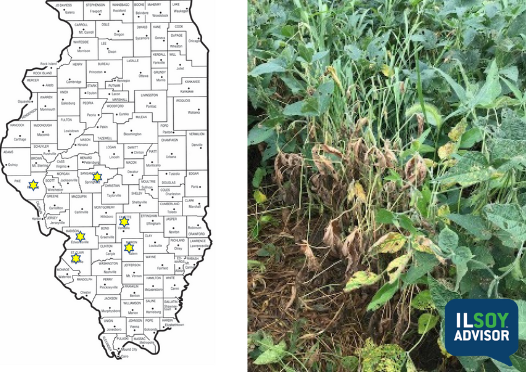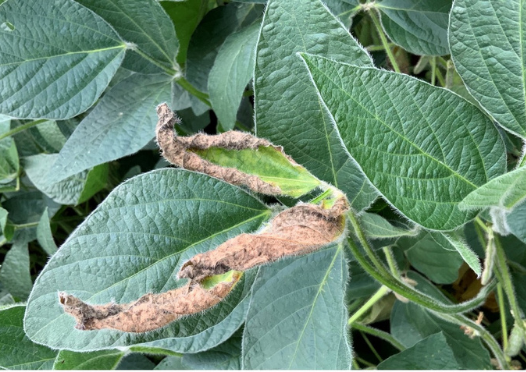ILSOYADVISOR POST
Disease Management: Who Saw Sudden Death Syndrome in Soybeans During 2015?
A common question at many agronomic meetings this winter has been “Why did we not see as much SDS in 2015?”
The 2014 season will be remembered as one of the worst for Sudden Death Syndrome (SDS). This fungal pathogen survives in soybean residue and infects the roots of soybean seedlings in the spring. If environmental conditions are conducive, the fungus can continue to colonize the root cortex during vegetative growth stages. Then, during reproductive stages—if the fungus continues to grow into the vascular tissue of the root—a toxin is released that disrupts water and nutrient flow resulting in yellow foliar symptoms and yield reductions.
Those hardest hit by the disease in 2014 appeared to have planted soybeans between May 6 and 10, and unfortunately many growers planted at that same time. The pathogen that causes SDS favors early season temperatures around 60 F. In Figure 1, you can see that SDS was present in the outlined areas that consisted of cool, early season temperatures. When comparing 2015 and 2014, the difference appears that most of Central Illinois had warmer temperatures during early planting dates (May 6 and 10) in 2015, as seen in Figure 2. Therefore, later planting or warmer temperatures at planting are some reasons we saw less SDS in Central and Southern Illinois in 2015. However, areas in Northern Illinois did have cool, early season temperatures that were favorable for soybeans to become infected with SDS fungal pathogens.

Along with early season cool temperatures, heavy rains can also cause SDS pressure to intensify. You can see the areas with the heaviest rainfall in 2014 and 2015 on Figures 3 and 4, respectively. There is a star placed on an area with cool, early season temperatures and heavy rainfall at planting. As expected, this area was one of the worst hit by SDS in both 2014 and 2015.

This is just one example where the presence of this fungal pathogen in the soil combined with favorable conditions for its development caused high SDS severity. However, the drier conditions later in the season in areas of Northern Illinois helped to curb disease development and reduced potential yield loss due to SDS infection in 2015.
Ultimately, soybean yield loss will depend on SDS onset and severity. SDS is usually more severe when symptoms appear before soybean podfill. When symptoms occur early, yield loss occurs by way of reduced seed number, because flowers and pods can be aborted. Unfortunately, SDS symptoms can become more severe over time, and soybeans stressed by SDS can be more vulnerable to other root, stem and seed diseases. Soybeans that show symptoms after podfill can suffer yield loss due to reduced seed size, reduced pods and seed weight because seed quality could be at risk. As soybeans reach the later growth stages—such as R6—the final yield loss can be observed.
All soybean varieties can be susceptible to SDS, but planting soybeans with higher levels of resistance to SDS and SCN can be helpful. A rotation from soybean to corn will not help to combat SDS, because the fungal pathogen that causes SDS can survive on corn roots. The SDS pathogen favors soils that are compacted or not as easily drained. Therefore, improving soil drainage and eliminating compaction will also help to reduce risk of the onset of SDS. There are no foliar fungicides that can be used as rescue treatments for SDS, but there are seed treatments available—such as ILeVO®—that have proven results against soil borne pathogens as well as SCN.
Stephanie Porter is a Burrus Seed Sales Agronomist. Read more about Stephanie here.





Comments
Add new comment